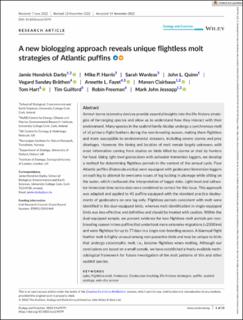A new biologging approach reveals unique flightless molt strategies of Atlantic puffins
Darby, Jamie; Harris, Mike P.; Wanless, Sarah; Quinn, John; Bråthen, Vegard Sandøy; Fayet, Annette; Clairbaux, Manon; Hart, Tom; Guillford, Tim; Freeman, Robin; Jessopp, Mark
Peer reviewed, Journal article
Published version

Åpne
Permanent lenke
https://hdl.handle.net/11250/3054348Utgivelsesdato
2022Metadata
Vis full innførselSamlinger
- Publikasjoner fra CRIStin - NINA [2364]
- Scientific publications [1392]
Sammendrag
Animal- borne telemetry devices provide essential insights into the life- history strate -gies of far- ranging species and allow us to understand how they interact with their environment. Many species in the seabird family Alcidae undergo a synchronous molt of all primary flight feathers during the non- breeding season, making them flightless and more susceptible to environmental stressors, including severe storms and prey shortages. However, the timing and location of molt remain largely unknown, with most information coming from studies on birds killed by storms or shot by hunters for food. Using light- level geolocators with saltwater immersion loggers, we develop a method for determining flightless periods in the context of the annual cycle. Four Atlantic puffins (Fratercula arctica) were equipped with geolocator/immersion loggers on each leg to attempt to overcome issues of leg tucking in plumage while sitting on the water, which confounds the interpretation of logger data. Light- level and saltwa -ter immersion time- series data were combined to correct for this issue. This approach was adapted and applied to 40 puffins equipped with the standard practice deploy -ments of geolocators on one leg only. Flightless periods consistent with molt were identified in the dual- equipped birds, whereas molt identification in single- equippedbirds was less effective and definitive and should be treated with caution. Within the dual- equipped sample, we present evidence for two flightless molt periods per non- breeding season in two puffins that undertook more extensive migrations (>2000 km) and were flightless for up to 77 days in a single non- breeding season. A biannual flight feather molt is highly unusual among non- passerine birds and may be unique to birds that undergo catastrophic molt, i.e., become flightless when molting. Although our conclusions are based on a small sample, we have established a freely available meth -odological framework for future investigation of the molt patterns of this and other seabird species.auks, flightless molt, Fratercula, Geolocator tracking, life-history strategies, puffin, seabird ecology, wet–dry sensor
